Tom's Guide Verdict
The Motorola Razr (2023) costs $300 less than foldable flip phones like the Motorola Razr+ and Galaxy Z Flip 5, and it's clear where Motorola cut corners to lower the price. But if you don't need a powerful processor or a larger cover display, this is the first foldable phone to be a viable option for more budgets.
Pros
- +
Costs $300 less than the next cheapest foldable
- +
Long-lasting battery
- +
Excellent design
- +
Solid low-light photos
Cons
- -
Tiny cover display
- -
Older Snapdragon 7 Gen 1 chip
- -
Screen not as bright as other foldables
Why you can trust Tom's Guide
The Motorola Razr (2023) has arrived to answer the demands of us who are intrigued by foldable phones, but who don't want to pay an arm and a leg to secure one. In a world where a $999 foldable used to be thought of as a relative bargain, the new Razr rewrites the script by slashing hundreds of dollars off that price.
To achieve that lower cost, Motorola had to make some sacrifices. The biggest one involves the phone's exterior display, which shrinks down from the glorious 3.6-inch panel on the pricier Motorola Razr+ to a more limited 1.5-inch strip. This cheaper Razr uses a less powerful chipset, too, and storage and display refresh rate specs are stripped back from the Plus model.
Is the lower price on the Motorola Razr worth it in exchange for the reduced cost of a foldable flip phone? Or are you giving up so much that any value is hopelessly squandered? That's what this Motorola Razr (2023) review aims to find out.
Motorola Razr (2023) review: Specs
| Motorola Razr 2023 | |
| Starting price | $699 |
| Main display | 6.9-inch pOLED (2640x1080; 144Hz) |
| Exterior display | 1.5-inch OLED (368x194; 120Hz) |
| CPU | Snapdragon 7 Gen 1 |
| RAM | 8GB |
| Storage | 128GB |
| Rear cameras | 64MP main (f/1.7) 13MP ultrawide (f/2.2) |
| Front camera | 32MP (f/2.4) |
| Battery size | 4,200 mAh |
| Battery life (Hrs:Mins) | 10:48 |
| Charging speed | 30W wired, 5W wireless |
| Size | 6.7 x 2.9 x 0.29 inches (open), 3.5 x 2.9 x 0.62 inches (closed) |
| Weight | 6.65 ounces |
| Colors | Sage Green; Vanilla Cream; Summer Lilac; Cherry Blossom |
Motorola Razr (2023) review: Price and availability
Price may well be the marquee feature of the Motorola Razr (2023), as it costs $699. That's a $300 discount from the Motorola Razr+. It also happens to be $300 less than Samsung's Galaxy Z Flip 5, which, at $999, is the cheapest device in Samsung's foldable arsenal. Motorola deserves some credit for beating Samsung to the punch on delivering a more affordable foldable.
There's one Motorola Razr model with 8GB of RAM and 128GB of storage. That's half the storage found in the Motorola Razr+.
The Motorola Razr goes on sale October 19, and you can buy it unlocked from Motorola, Amazon or Best Buy, which are all offering $100 discounts off the regular price as of this writing. In addition to those retailers, you can pick up a Motorola Razr from T-Mobile, Metro by T-Mobile, AT&T, Xfinity Mobile, USCellular, Boost Infinite, Boost Mobile and Consumer Cellular starting October 19; Cricket will offer the phone, too.
Motorola Razr (2023) review: Design

The Motorola Razr may be the lower cost version of Motorola's foldable flip phone, but you'd have a hard time telling the difference between it and the more expensive Razr+. The two devices are the same height and width, though the cheaper model is fractionally thicker and weighs 0.1 grams more. We're talking about a rounding error's worth of difference.
Get instant access to breaking news, the hottest reviews, great deals and helpful tips.
The similarities don't stop there. The vegan leather material on the exterior of the Razr+ makes its way to the Razr, as does the Corning Gorilla Glass Victus display. Of those features, I'm most appreciative of the vegan leather, which gives the Motorola Razr a classy look that disguises its midrange price, and feels good to grip when you're holding the phone.
Even with the Gorilla Glass Victus, the Razr isn't indestructible. As with the Razr+, Motorola's phone has an IP52 rating, meaning it can repel water, but you sure don't want to drop your device in it.
That said, the Razr feels solidly built enough to stand up to daily use. Some effort is needed to open up the phone — it's not something I could do one-handed. However, closing the phone can be done without too much effort, which is accompanied by a satisfying thwap as the two halves come together. Plus, in good news to those who hate gaps, the Razr shuts completely flat.

You can get the Motorola Razr in Sage Green, Vanilla Cream, Summer Lilac or Cherry Blossom. The green of my Razr certainly looked striking, though it did tend to pick up dust and lint when stashed in my pocket.
You're able to set up the Motorola Razr to unlock with a thumbprint — the sensor lives on the power button on the right side of the phone. Sensor readings were very accurate, as I never had an issue unlocking the Razr, but I found that button's location just north of the Razr's hinge to be hard to pin down sometimes, as I would hit the down volume button by mistake frequently. That's likely something I'd get used to over time, though.
Motorola Razr (2023) review: Display
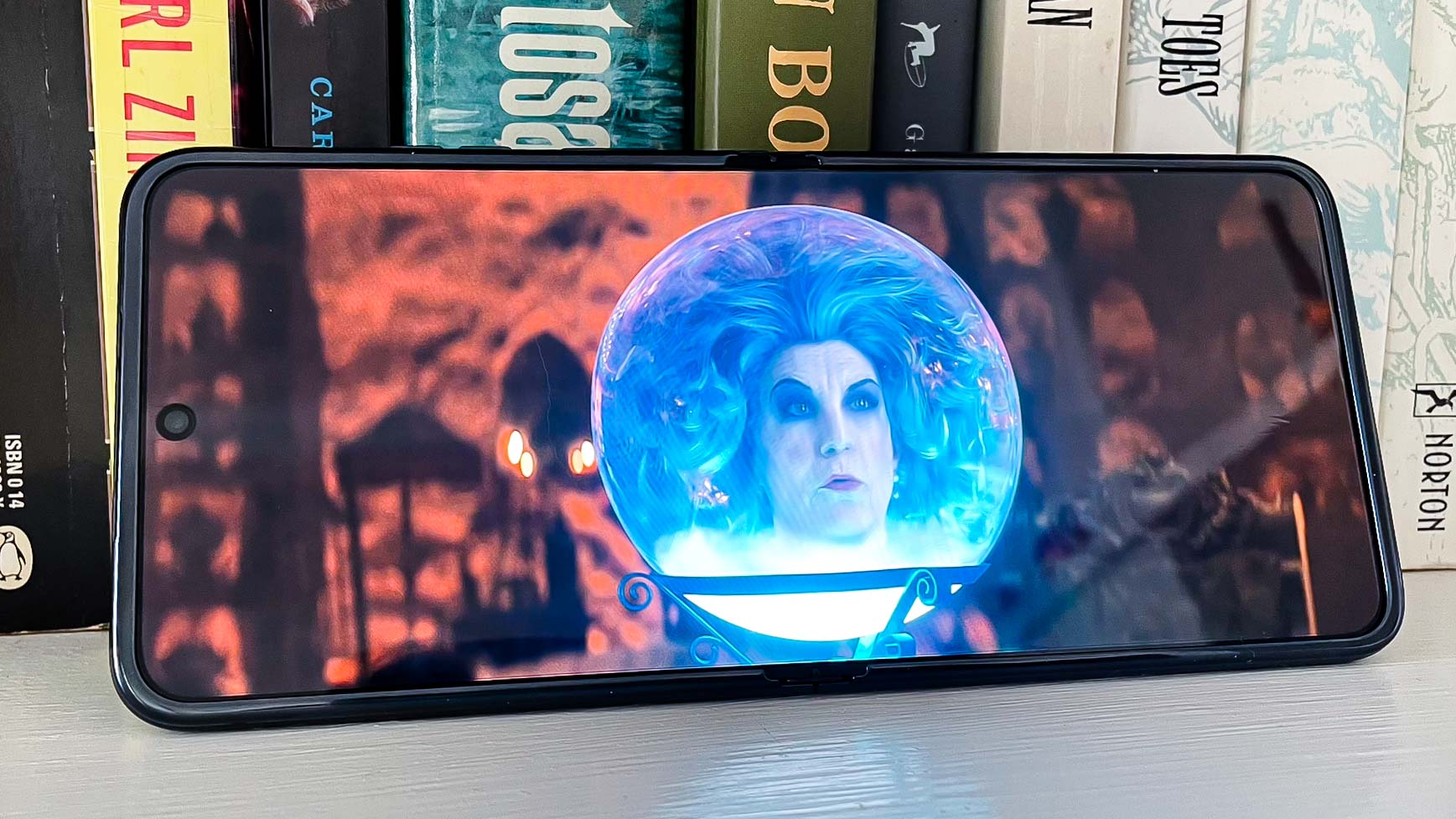
Like its more-expensive sibling, the Motorola Razr unfolds to reveal a 6.9-inch polymer OLED (pOLED) panel, which gives you plenty of screen real estate for working with apps, playing games, and doing the kind of things on your phone that feel more restrictive on smaller displays. The big change is here is the panel's refresh rate — it's scaled down to 144Hz on the Motorola Razr versus 165Hz on the Razr+.
This downgrade really isn't much of a sacrifice, especially considering that there are more expensive phones out there that ask you to settle for 60Hz (looking at you, iPhone 15). Scrolling is perfectly smooth on the Razr's main screen, and I imagine games designed to take advantage of the faster refresh rates will look good, too.
The more significant change is the removal of the 3.6-inch panel on the outside of the Razr+. Instead, you've got a 1.5-inch pOLED strip that's big enough for notifications and not much else.
You can use the 1.5-inch display as a makeshift viewfinder for those times when you want to use the more powerful exterior camera for a selfie, but I found it hard to line myself up for a well-positioned shot, since you can't see your full face on the screen. It's definitely a challenge when compared to a phone like the Galaxy Z Flip 5, which also adopted a larger exterior screen like the Razr+'s panel. There's no comparing which flip phone makes it easier to snap selfies without ever opening up the device.
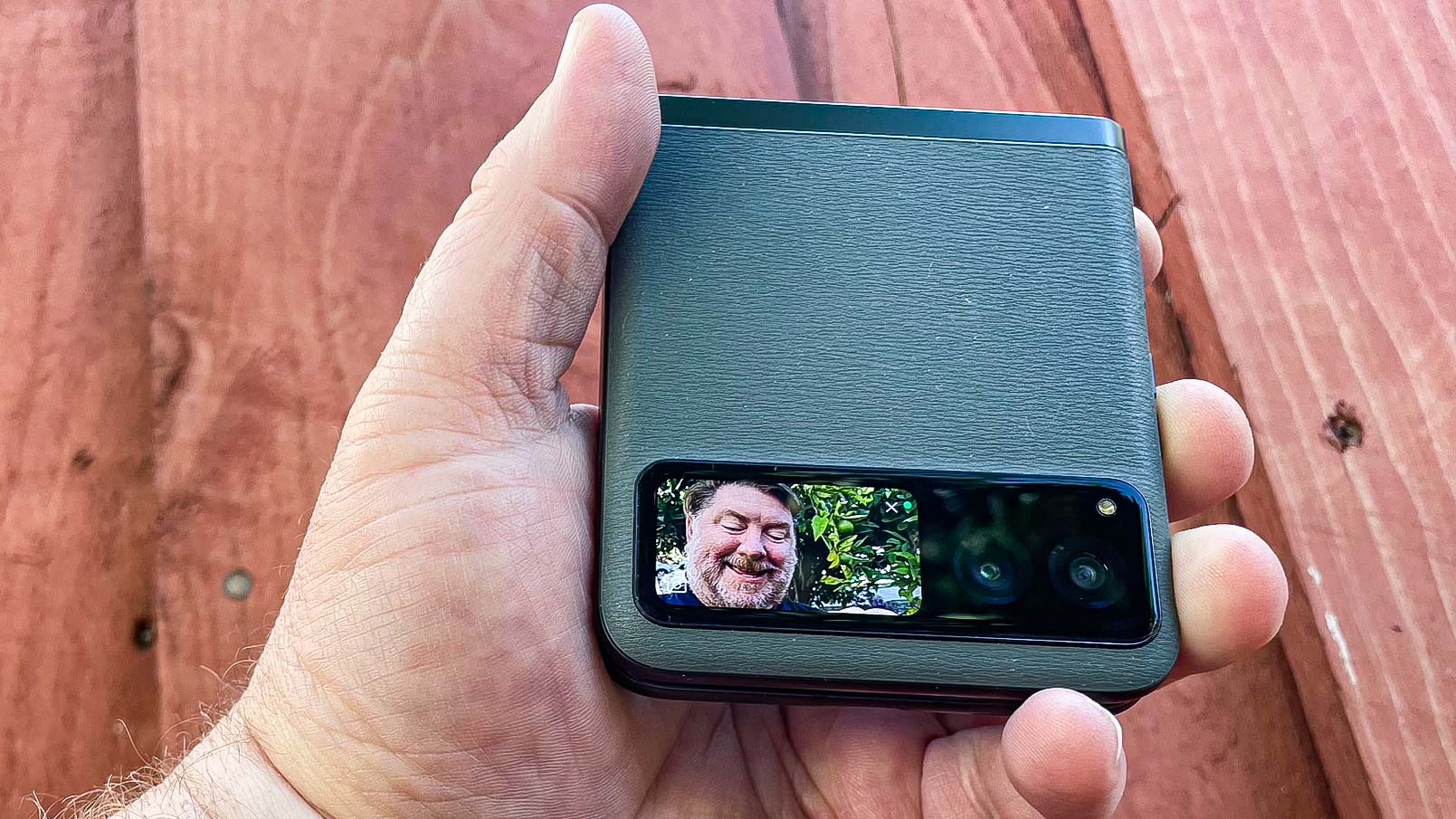
You lose something else besides a better camera viewfinder with the switch to a 1.5-inch outer display. One of the big appeals of the Razr+ was the ability to run apps on that exterior display — saving you the hassle of having to open phone to take care of a quick task. That's not an option with the regular Razr, though you can set up the outer screen to swipe between widgets. For example, I have my Razr showing the local temperature and upcoming events.

Watching videos on the Razr's screen is a pleasure, though the 22:9 aspect ratio may be a little bit wider than what you're used to with videos on a more conventionally shaped phone. I certainly had a good time streaming the new Haunted Mansion movie on Disney Plus — the film uses a lot of dark lighting to set the mood with a blueish cast to show off the mansion's 999 ghosts, but the Razr did a solid job conveying the spookiness without losing visual details in the shadows.
Our testing reflected my experience, as we measured the Razr's main display picking up 155.3% of the DCI-P3 color gamut with its display set to Saturated, essentially the same percentage as the Razr+'s display. That's a higher percentage than the Galaxy Z Flip 5's 128.7% result in Vivid mode.
Colors on the Galaxy Z Flip 5 are more accurate, though, given the Delta-E score of 0.08 for the Samsung phone. Meanwhile, the Motorola Razr posted a 0.32 result (Numbers closer to zero represent more accurate colors.)
| Row 0 - Cell 0 | Motorola Razr | Samsung Galaxy Z Flip 5 | Motorola Razr+ |
| Display size | 6.9 inches (2640 x 1080) | 6.7 inches (2640 x 1080) | 6.9 inches (2640 x 1080) |
| sRGB (%) | 219.3 (Saturated) / 106.9 (Natural) | 181.6 (Vivid) / 114 (Natural) | 218.9 (Saturated) / 101.5 (Natural) |
| DCI-P3 (%) | 155.3 (Saturated) / 75.7 (Natural) | 128.7 (Vivid) / 80.8 (Natural) | 155.1 (Saturated) / 71.9 (Natural) |
| Delta-E | 0.32 (Saturated) / 0.29 (Natural) | 0.08 (Vivid) / 0.28 (Natural) | 0.35 (Saturated) / 0.22 (Natural) |
| Brightness Nits | 1,003 | 1,126 | 970 |
If I have a complaint about the Motorola Razr screen, it's that the display isn't as bright as the Galaxy Z Flip 5. With HDR brightness turned on, the Motorola Razr hit 1,003 nits on our light meter. That's pretty good for a $699 phone, but it's short of the 1,126-nit reading we got from the Galaxy Z Flip 5 under similar conditions. Plus, without HDR brightness enabled, I found it best to turn off adaptive brightness and crank the display to its maximum brightness in order to see the Razr screen in bright sunlight.
Motorola Razr (2023) review: Cameras
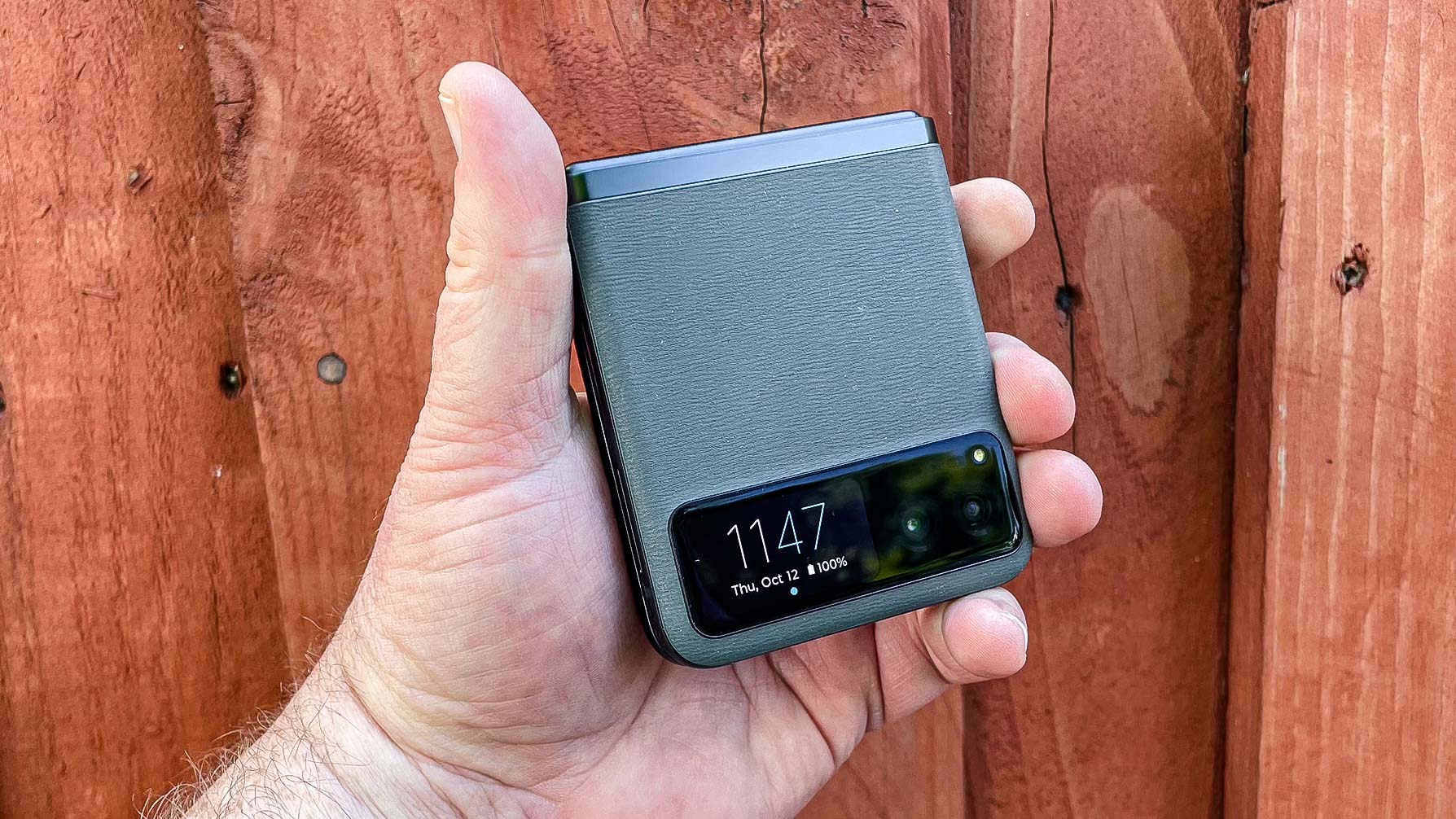
One area where Motorola didn't scale back with this new Razr involves the phone's cameras. In fact, the Razr features a camera with a higher megapixel rating for its main shooter — a 64MP sensor compared to 12MP on the Razr+. And yes, you can shoot at the full 64MP resolution if you want, though by default, pixel binning will produce a 16MP shot. As with the Razr+, a 13MP ultrawide camera joins the main shooter on the exterior of the phone.
You can understand why Motorola went with a higher-resolution main camera on its less expensive phone. The audience for Razr flip phones are likely to live well-documented lives with many photos uploaded to Instagram and other photo-sharing sites. This is one area where Motorola has no incentive to skimp in an effort to keep the Razr's price down — it needs cameras that can hold their own against more expensive phones.
To find out just how well the Motorola Razr pulls that off, I took the phone out for a photo face-off with the Galaxy Z Flip 5. Cameras have not been a strong suit traditionally for Samsung's foldable flip phone, though the Z Flip 5 improved things considerably in that area. At any rate, its two 12MP rear cameras should give us an idea of how the Motorola Razr measures up.
At first glance, the Motorola Razr does well in these dueling photos of a cheeseburger. The kimchi slathered on top of the burger is an appropriate shade of day-glo orange in the Moto photo, and the patty itself looks rich and meaty. I would have said that the Razr photo closely matches what the Galaxy Z Flip 5 captured — until I caught sight of the onion rings in the background. They're a little out of focus in the Razr shot, whereas the Flip 5 keeps the entire scene looking sharp.
The Motorola Razr makes a much show of it with a photo of a persimmon ripening on a tree in my yard. You could argue that the Galaxy Z Flip 5's shot is better, as it's captured more details in the leaves. (It's also pumped up the green colors in the photos — a not-uncommon issue with Samsung photo-processing). But I prefer the solid orange color of the persimmon in the Motorola Razr shot. It doesn't have the slightly overexposed sheen on the upper right portion of the fruit that you see in the Flip 5 shot. Everything just looks more balanced to me in the Razr image.
I'm split on this portrait shot I took of my daughter. On the one hand, I prefer the warmer skin tone in the Razr's photo, and I think the blur effect is pretty thorough; I'm also impressed with how the photo recreates the texture of her shirt. However, the warm skin tone in the Razr shot comes at the expense of details like her freckles which remain visible on the Galaxy Z Flip 5's portrait. Her eyes also look brighter in the Samsung shot, as the Razr leaves some dark circles around her eyes.
Ultimately, the Galaxy Z Flip 5 takes the better portrait, as there's more depth to its shot. In contrast, the Razr picture seems a little flat. But I do think Motorola's effort is at least in the same ballpark.
At night, the Motorola Razr takes the superior shots, with this photo of some Halloween decorations showcasing the superiority of its night mode. Both shots are just about even, but the Razr wins out on color — the skeleton and the deck chair look a lot like they do in real life. Samsung's phone has added a blue-ish tint to the scene. It's not a poor shot by any means, but the photo looks a little less accurate to my eye.
Moving to the ultrawide lens, the Motorola Razr has a hard time keeping up with the Galaxy Z Flip 5. Samsung has once again pumped up the color, but here it serves the shot well. The little amount of green remaining in the sun-scarred lawn pops and the sky is a richer, deeper shade of blue. That helps the jet stand out in the Flip 5 shot in a way that it doesn't in the Razr's effort — instead the jet blends into the background, and the entire photo looks pretty barren.

The ultrawide camera on the Motorola Razr can also serve as a macro camera — a use case I prefer to having a dedicated (and usually supbar) macro lens. This close-up shot of a ripening fig is a mixed bag, as it's slightly overexposed. Still, I like the blackish purple coloring of the fig that the Razr managed to capture, and the texture of the fruit itself is very detailed.
Open up the Motorola Razr, and you get a 32MP selfie cam that generally combines four pixels into one for an 8MP photo. I can't pretend to pleased with the Razr's effort here, as it makes my skin look fairly sallow. The Flip 5 injects some color into my face, and the details of my beard are a little better defined.
Of course, why settle for a selfie camera when the form factor of a foldable lets you take a self-portrait using the more advance main camera. With the Razr closed, all you have to do is flick your wrist and you can activate the outside camera (there's some satisfying haptic feedback to let you know that the camera is launching). Pressing either volume key snaps a shot, and you can also trigger photos by tapping the exterior screen, enabling the phone's auto-smile feature or raising your palm for the capture gesture that's part of Moto Actions.
The skin tone problem that appeared with the front camera also flares up when I shot a self-portait with the 64MP main sensor. At any rate, the picture is overly cool, especially when compared to the Galaxy Z Flip 5 photo (also shot with that phone's main camera), which manages to inject some warmth into my skin tone. My green shirt is a little sharper in Samsung's photo, too.
I wouldn't argue that the Motorola Razr camera is superior to the one on the Galaxy Z Flip 5. Really, only the night photos and a few other shots taken with main camera top what Samsung's flip phone produced. But more crucially, in the photos where Samsung takes the better shots, I don't see $300 worth of difference. The Motorola Razr holds its own, and if you're looking for a foldable phone on a budget, the fact that this camera phone is within shouting distance of a $999 device is not an insignificant one.
Motorola Razr (2023) review: Performance

The Motorola Razr story is one of trade-offs, and the chipset powering this less expensive model is an example of that idea. While the Motorola Razr+ ran on the Snapdragon 8 Gen 1 chipset from Qualcomm's top-performing family of silicon, the standard Razr uses a Snapdragon 7 Gen 1. That's a less expensive chipset, sure, but it also packs less of a performance punch.
You can see that in our benchmark testing. On Geekbench 6, the Motorola Razr posts single and multicore results of 1,053 and 3,053, respectively. Those are decent numbers, but they're short of the Motorola Razr's 1,817 and 4,635 results. It also trails the Galaxy Z Flip 5 (1,857 and 5,115), which runs on a Snapdragon 8 Gen 2 system-on-chip optimized for Samsung phones.
| Row 0 - Cell 0 | Motorola Razr | Samsung Galaxy Z Flip 5 | Motorola Razr+ |
| Chipset | Snapdragon 7 Gen 1 | Snapdragon 8 Gen 2 | Snapdragon 8 Gen 1 |
| Geekbench 6 (single / mulitcore) | 1053 / 3053 | 1857 / 5115 | 1817 /4635 |
| 3DMark Wild Life Unlimited (fps) | 18.8 | 76.2 | 66.8 |
| Adobe Premiere Rush (Mins:Secs) | 1:47 | 0:42 | 0:44 |
The story is much the same on graphics tests, where the Motorola Razr reaches 18.8 frames per second on 3DMark's Wild Life Unlimited. That's well behind both the Razr+ (66.8 fps) and Galaxy Z Flip 5 (76.2 fps). In real world testing, where we transcode a video using Adobe Premiere Rush, the Motorola Razr needed 1 minute and 47 seconds to complete the task, which is more than a minute longer than the Razr+'s 44-second time.
In other words, the Motorola Razr is not the foldable to turn to if you need to run demanding apps. That said, the slower chipset doesn't translate into noticeable delays when jumping between apps or running games like PUBG Mobile or Mario Kart Tour. Both games performed well on my Motorola Razr, without any lags or skips.
Motorola Razr (2023) review: Battery life and charging
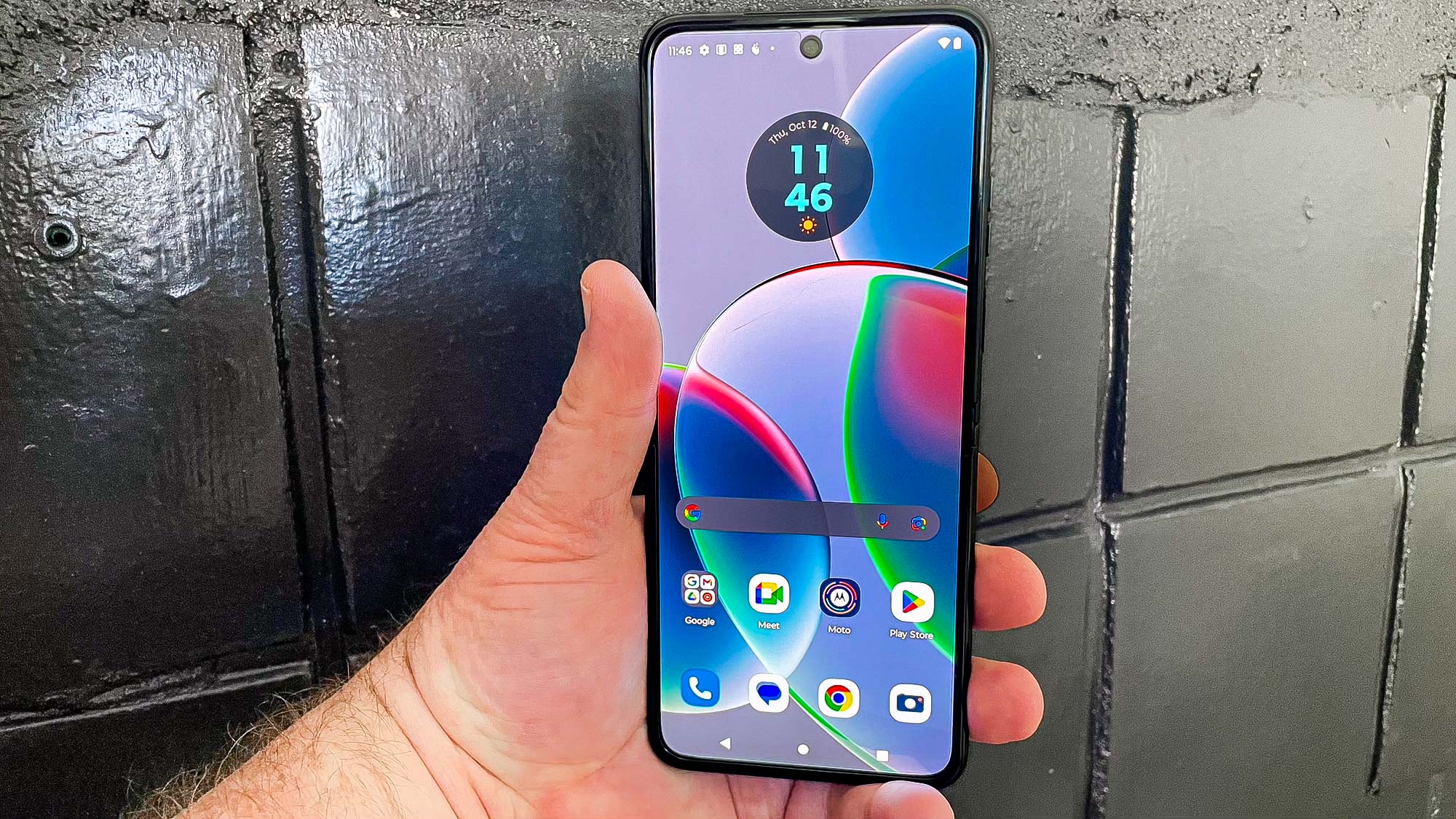
Foldable phones haven't always been paragons of long-battery life, though that's beginning to change as phone makers figure out a way to keep larger screens and external panels powered up without an appreciable hit on battery life. I'm happy to report the Motorola Razr is very much a part of that trend.
Every phone we review goes through our battery life test, in which we set a phone's main display to 150 nits, and have the phone surf the web over cellular until it runs out of power. The Motorola Razr turned in an impressive average of 10 hours and 48 minutes, which is nearly an hour better than the average smartphone. That's an impressive feat given the average smartphone usually has a much smaller display to keep powered up.
Even better, we got that result while testing the Motorola Razr with its refresh rate on the default adaptive 144Hz setting. We'd also note that the Razr beat the Razr+ by nearly 40 minutes in our testing, though the cheaper phone does have a bigger battery (4,200 mAh compared to 3,800 mAh).
The Motorola Razr ships with a wall charger that delivers 30W charging speeds, which matches what the Google Pixel 8 promises. Wireless charging occurs at a more pedestrian 5W speed for the Razr.
Motorola Razr (2023) review: Software
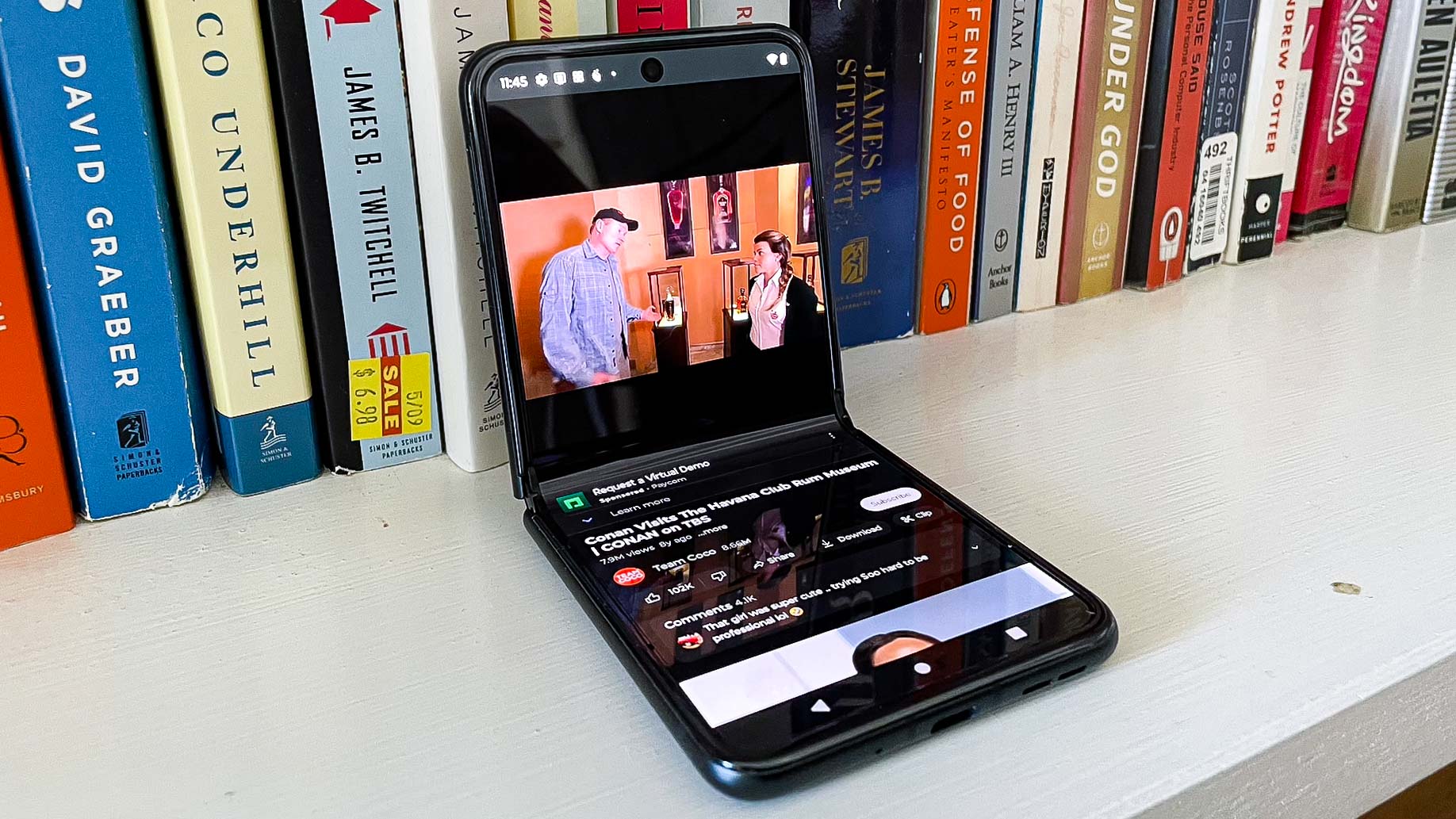
As a foldable phone, the Motorola Razr boasts a few features that take advantage of the unique design, such as Flex View. Here, you can position the phone at a 90-degree angle with the top half of its display pointing upward — the upper portion of the screen becomes a viewing area, while the bottom features controls.
I used Flex View to watch YouTube videos on one half of the Razr's screen, while controlling playback from the bottom. It's convenient to have those controls at the ready, but I found the picture on the upper portion of the screen a little cramped.
Like other Moto phones, the Razr supports gestures that act as shortcuts based on what you do with your hands and fingers. (Think of that wrist twist that launches the camera or using three fingers to trigger a screenshot.) Other than that, this is a pretty clean version of Android running on the Razr — Android 13 to be specific.
Motorola promises three years of Android OS updates for the Razr, just like it does with the Razr+. You'll get an additional year of security updates. That's more generous that Motorola's usual approach to lower cost phones, but with Google now providing seven years of support for its Pixel flagships, Motorola's approach pales in comparison.
There's one other software addition to the Razr worth talking about — Motorola Unplugged. This new setting lets you tune out potential distractions by setting aside time where only selected apps and notifications appear. You can even change your app layout and wallpaper to something less likely to tempt you into checking social media or paying more attention to your phone than the world and people around you.

I'll need to spend more time with Unplugged to assess how effective this digital detox is, but on the surface, it doesn't sound that different from the Focus mode available through the iPhone's iOS software. And from my experience, the features that help you unplug are only as good as the will power of the person using the phone.
More Motorola customers will soon find out just how effective the Unplugged feature is — Motorola is planning to bring it to more phones starting with the Razr+.
Motorola Razr (2023) review: Verdict
I'm not about to argue that the Motorola Razr (2023) is better than either the Motorola Razr+ or Galaxy Z Flip 5. Those devices are battling it out for the best foldable phone title, and the generously-sized external display on both flip phones is a big reason why. Without that feature, the standard Razr is a more limited device.
But the Razr doesn't need to be better than those other foldables — it just needs to pack enough value to where you might not mind giving up an external display or a more powerful chipset if it means a foldable phone for $300 less. On that front, the Motorola Razr delivers.
The cameras on the Motorola Razr — really, the chief draw of most smartphones these days — are close enough in photo quality to what more expensive foldable flip phones can produce. The cheaper Razr also lasts a good long while on a charge, and there's no noticeable trade-offs you have to make on design. This is a much better-looking phone than its price tage would have you think.
If a larger external display will help you get more out of your phone, you should find a way to pay the extra $300 for the Razr+. But if that feature doesn't matter to you, the Motorola Razr is an excellent alternative — and hopefully first of many devices to drive down the cost of foldable phones.
Philip Michaels is a Managing Editor at Tom's Guide. He's been covering personal technology since 1999 and was in the building when Steve Jobs showed off the iPhone for the first time. He's been evaluating smartphones since that first iPhone debuted in 2007, and he's been following phone carriers and smartphone plans since 2015. He has strong opinions about Apple, the Oakland Athletics, old movies and proper butchery techniques. Follow him at @PhilipMichaels.


